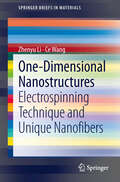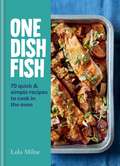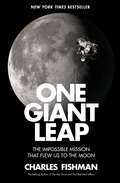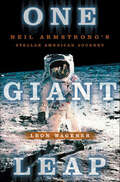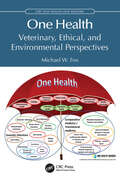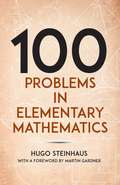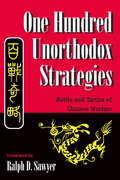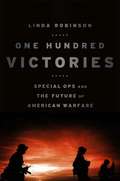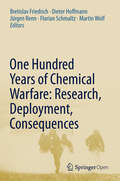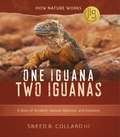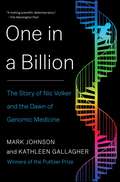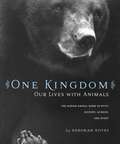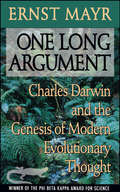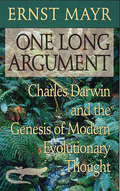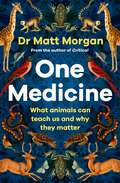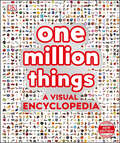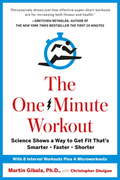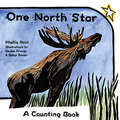- Table View
- List View
One-Dimensional nanostructures
by Ce Wang Zhenyu LiOne-Dimensional Nanostructures: Electrospinning Technique and Unique Nanofibers is a comprehensive book depicting the electrospinning technique and related 1D unique electrospun nanofibers. The first part of the book focuses on electrospinning technique, with chapters describing Electrospinning setup, electrospinning theories, and related working parameter. The second part of the book describes in detail specific topics on how to control the electrospun fiber properties such as how to control the fiber direction, how to control the fiber surface morphology, how to control the fiber structure, and how to construct 3D structures by electrospun fibers. The final part of the book depicts the applications of the electrospun nanofibers, with sections describing in detail specific fields such as electrospun nanofiber reinforcement, filtration, electronic devices, lithium-ion batteries, fuel cells, biomedical field, and so on. One-Dimensional Nanostructures: Electrospinning Technique and Unique Nanofibers is designed to bring state-of-the-art on electrospinning together into a single book and will be valuable resource for scientists in the electrospinning field and other scientists involved in biomedical field, mechanical field, materials, and energy field. Dr. Zhenyu Li is an associate professor at the Dept. of Chemistry, Jilin University, Changchun, P. R. China. Currently, he also holds the position in Australian Future Fibres Research & Innovation Centre, Institute for Frontier Materials, Deakin University, Geelong, Victoria, Australia. Dr. Ce Wang is a professor at the Dept. of Chemistry, Jilin University, Changchun, P. R. China.
One-Dimensional Polymeric Nanocomposites: Synthesis to Emerging Applications
by Ram K. GuptaOne-dimensional nanomaterials are emerging as promising materials for their many unique characteristics. This book covers their synthesis and applications in batteries, supercapacitors, fuel cells, solar cells, green energy production, flexible electronics, electrochemical sensors, and biomedicine. Progress in nanotechnology offers an opportunity to synthesize materials with unique properties. The properties of nanomaterials can be further improved by growing them in one-dimension structural with variations in their architecture. One-dimensional polymeric nanocomposites offer various advantages such as nano dimensions, high surface area, structural stability, and the ability to tune their electrochemical, electronic, and optical properties. The book covers basic concepts, chemistries, properties, and the importance of one-dimensional nanomaterials, along with their wide applications and state-of-the-art progress in the energy, flexible electronics, sensor, and biomedical fields. The fundamentals of electrochemical behavior and their understanding for various applications are also discussed in detail. This book will provide new direction to scientists, researchers, and students to better understand the chemistry, technologies, and applications of one-dimensional polymeric nanocomposites.
One-dimensional Transition Metal Oxides and Their Analogues for Batteries (SpringerBriefs in Materials)
by Huan Pang Guangxun Zhang Xiao Xiao Huaiguo XueThis book highlights the use of one-dimensional transition metal oxides and their analogue nanomaterials for battery applications. The respective chapters present examples of one-dimensional nanomaterials with different architectures, as well as a wide range of applications, e.g. as electrode materials for batteries. The book also addresses various means of synthesizing one-dimensional nanomaterials, e.g. electrospinning, the Kirkendall effect, Ostwald ripening, heterogeneous contraction, liquid-phase preparation, the vapor deposition approach and template-assisted synthesis. In closing, the structural design, optimization and promotion of one-dimensional transition metal oxide electrode materials are discussed. The book chiefly focuses on emerging configurable designs, including core-shell architectures, hollow architectures and other intricate architectures. In turn, the applications covered reflect essential recent advances in many modern types of battery. Accordingly, the book offers an informative and appealing resource for a wide readership in various fields of chemical science, materials and engineering.
One Dish Fish: Quick and Simple Recipes to Cook in the Oven
by Lola Milne<p>Cooked in the oven in just one dish or roasting tin, all the recipes here are ready within 20, 30 or 45 minutes, allowing you to enjoy a wide variety of fish and seafood with no faff or fiddle.<p> <p>Even those who are otherwise confident in the kitchen can sometimes feel intimidated by fish, but Lola Milne proves there's no need to be fearful, with 70 delicious, foolproof dishes that are perfect for seafood lovers of all cooking abilities.<p> <p>From Panko-Crusted Cod, Monkfish Tagine and Peppers & Aubergine with Anchovies & Olives to Slow-roasted Salmon with Citrus, Harissa & Capers, these are the ideal recipes to solve your weeknight dinner dilemmas.<p>
One Giant Leap
by Don BrownAs a young boy, Neil Armstrong had a recurring dream in which he held his breath and floated high above the people, houses, and cars. He spent his free time reading stacks of flying magazines, building model airplanes, and staring through the homemade telescope mounted on the roof of his neighbor's garage. As a teenager, Neil became obsessed with the idea of flight, working odd jobs to pay for flying lessons at a nearby airport. He earned his student pilot's license on his sixteenth birthday. But who was to know that this shy boy, who also loved books and music, would become the first person to set foot on the moon, on July 20, 1969. Here is the inspiring story of one boy's dream - a dream of flying that landed him more than 200,000 miles away in space, gazing upon the awesome sight of a tiny earth hanging suspended in a perfectly black sky. On the thirtieth anniversary of the moon landing, Don Brown's expressive story reveals the achievement of this American legend, Neil Armstrong, re
One Giant Leap: The Impossible Mission That Flew Us to the Moon
by Charles FishmanThe remarkable story of the trailblazers and the ordinary Americans on the front lines of the epic mission to reach the moon.President John F. Kennedy astonished the world on May 25, 1961, when he announced to Congress that the United States should land a man on the Moon by 1970. No group was more surprised than the scientists and engineers at NASA, who suddenly had less than a decade to invent space travel. <P><P>When Kennedy announced that goal, no one knew how to navigate to the Moon. No one knew how to build a rocket big enough to reach the Moon, or how to build a computer small enough (and powerful enough) to fly a spaceship there. No one knew what the surface of the Moon was like, or what astronauts could eat as they flew there. <P><P>On the day of Kennedy’s historic speech, America had a total of fifteen minutes of spaceflight experience—with just five of those minutes outside the atmosphere. Russian dogs had more time in space than U.S. astronauts. Over the next decade, more than 400,000 scientists, engineers, and factory workers would send 24 astronauts to the Moon. <P><P>Each hour of space flight would require one million hours of work back on Earth to get America to the Moon on July 20, 1969. Fifty years later, One Giant Leap is the sweeping, definitive behind-the-scenes account of the furious race to complete one of mankind’s greatest achievements. It’s a story filled with surprises—from the item the astronauts almost forgot to take with them (the American flag), to the extraordinary impact Apollo would have back on Earth, and on the way we live today. <P><P>Charles Fishman introduces readers to the men and women who had to solve 10,000 problems before astronauts could reach the Moon. From the research labs of MIT, where the eccentric and legendary pioneer Charles Draper created the tools to fly the Apollo spaceships, to the factories where dozens of women sewed spacesuits, parachutes, and even computer hardware by hand, Fishman captures the exceptional feats of these ordinary Americans. <P><P>One Giant Leap is the captivating story of men and women charged with changing the world as we knew it—their leaders, their triumphs, their near disasters, all of which led to arguably the greatest success story, and the greatest adventure story, of the twentieth century. <P><b>A New York Times Bestseller</b>
One Giant Leap: Neil Armstrong's Stellar American Journey
by Leon WagenerOn July 20, 1969 the whole world stopped. It was a day in which a man who grew up on a farm without electricity would announce, "One small step for man, one giant leap for mankind."In this, the first ever biography of Neil Armstrong, Leon Wagener explores the man whose walk on the moon is still compared to humankind's progenitor's crawl out of the primordial ooze. And whose retreat back to a farm in his native Ohio soon after the last ticker tape confetti fell, has left him looked upon as a reclusive hermit ever since.This is the true story of a national hero, whose life long quest to walk on the moon truely mirrors our best selves, an American who braved incredible danger daily over a long career, finally achieving what seemed impossible, and broke free of the Earth's surly bonds proving forever that man can reach for the stars, and succeed.Relying on hundreds of interviews with family and friends of the astronaut, plus generous access to the NASA files, Leon Wagener explores the life of one of America's true heroes, in a book filled with extraordianry adventure, and even greater achievement.At the Publisher's request, this title is being sold without Digital Rights Management Software (DRM) applied.
One Green Thing: Discover Your Hidden Power to Help Save the Planet
by Heather WhiteThe climate crisis is the biggest challenge of our time, and we all have a unique role to play. Start here and now with this book. In this revolutionary call to action, unlock your superpower through a daily practice of sustainability.Noted environmentalist Heather White offers an easy-to-follow guide for climate action while brilliantly weaving together warm and funny stories from her childhood in East Tennessee, anecdotes from 20+ years of environmental advocacy, and scenes from parenting two GenZ daughters in Bozeman, Montana. In One Green Thing, White shows you how to contribute to the climate movement through self-discovery – your personality, interests, and strengths.First, you&’ll take the Service Superpower Profile Assessment, which will reveal your special gifts in service to others and the planet. Based on your profile, you&’ll then be equipped to:Begin your adventure with a 21-Day Kickstarter Plan that shares specific actions you can takeUse the Eco-Impact Top Ten—the primary areas that can affect positive, lasting change—to develop an individualized Eco-Action PlanLog the mental health benefits and measure your progress with the Joy TrackerWrite about your journey and your &“why&” for taking action with exercises and journal prompts that encourage you to reflectListen and talk with members of Gen Z about their climate anxietyCommit to being an awesome ancestor for future loved ones as you inspire your family, friends, and community to work toward a regenerative, sustainable world Setting the intention each day to take a small step— a &“one green thing&” to care for the planet--can help ease your eco-anxiety, push the culture toward climate solutions, and create a sense of joy.
One Health: Veterinary, Ethical, and Environmental Perspectives (CRC One Health One Welfare)
by Michael W. FoxThis collection of reflective, critical, philosophical, and practical chapters represents the author’s 60 years as a veterinarian, ethologist, and bioethicist. The rising incidence of zoonotic diseases from farmed animals and wildlife in the expanding human population and so-called reverse zoonoses where humans are infecting other species are existential concerns. These concerns are linked with anthropogenic climate change and our impact on ecosystems which threaten biodiversity and the health and future of Homo sapiens and many other species.These interconnected issues are examined in this book, broadening the scope and agenda of what is currently more narrowly practiced as preventive medicine. The author calls for greater emphasis on holistic preventive health-care maintenance in response to the escalating costs of human and companion animal health problems, the welfare of factory farmed animals, and endangered status of many wild species.Our species now faces a complex existential crisis that must be addressed in an interdisciplinary way, because there are multiple contributing factors; factors that call for the insights of science and bioethics. Fearlessly tackling contentious issues and 'wicked problems,' Dr Michael W. Fox offers an integrated perspective of what One Health looks like on the ground.
One Health: Food Safety and Security, and International and National Plans for Implementation of One Health Activities (Current Topics in Microbiology and Immunology #366)
by John S. Mackenzie, Martyn Jeggo, Peter Daszak and Juergen A. RichtOne Health is an emerging concept that aims to bring together human, animal, and environmental health. Achieving harmonized approaches for disease detection and prevention is difficult because traditional boundaries of medical and veterinary practice must be crossed. In the 19th and early 20th centuries this was not the case—then researchers like Louis Pasteur and Robert Koch and physicians like William Osler and Rudolph Virchow crossed the boundaries between animal and human health. More recently Calvin Schwabe revised the concept of One Medicine. This was critical for the advancement of the field of epidemiology, especially as applied to zoonotic diseases. The future of One Health is at a crossroads with a need to more clearly define its boundaries and demonstrate its benefits. Interestingly the greatest acceptance of One Health is seen in the developing world where it is having significant impacts on control of infectious diseases.
One Hundred Problems in Elementary Mathematics (Dover Books on Mathematics)
by Martin Gardner Hugo SteinhausBoth a challenge to mathematically inclined readers and a useful supplementary text for high school and college courses, One Hundred Problems in Elementary Mathematics presents an instructive, stimulating collection of problems. Many problems address such matters as numbers, equations, inequalities, points, polygons, circles, ellipses, space, polyhedra, and spheres. An equal number deal with more amusing or more practical subjects, such as a picnic ham, blood groups, rooks on a chessboard, and the doings of the ingenious Dr. Abracadabrus.Are the problems in this book really elementary? Perhaps not in the lay reader’s sense, for anyone who desires to solve these problems must know a fair amount of mathematics, up to calculus. Nevertheless, Professor Steinhaus has given complete, detailed solutions to every one of his 100 problems, and anyone who works through the solutions will painlessly learn an astonishing amount of mathematics. A final chapter provides a true test for the most proficient readers: 13 additional unsolved problems, including some for which the author himself does not know the solutions.
One Hundred Unorthodox Strategies
by Ralph D. SawyerOne Hundred Unorthodox Strategies was compiled in the fifteenth century, during the Ming Dynasty, as a handbook of tactics based on Chinese military classics. Translated into English for the first time, this unique work draws on over two thousand years of experience in warfare to present a distillation of one hundred key strategic principles. Originally prepared as a text for students aspiring to high political positions in Confucian China, One Hundred Unorthodox Strategies is a compendium of Oriental strategies concisely stated and each individually illustrated with a description of battle from Chinese history. These historical examples shed new light on the often enigmatic formulations of the ancient strategists on subjects such as Strategic Power, Defense, Vacuity, Spirit, and Victory. Acclaimed translator and Chinese military specialist Ralph Sawyer adds his own thoughtful commentary, deepening the reader’s understanding of the intricacies of Chinese strategic thought.
One Hundred Victories: Special Ops and the Future of American Warfare
by Linda Robinson"One Hundred Victories" is a portrait of how?after a decade of intensive combat operations?special operations forces have become the go-to force for US military endeavors worldwide. Linda Robinson follows the evolution of special ops in Afghanistan, their longest deployment since Vietnam. She has lived in mud-walled compounds in the mountains and deserts of insurgent-dominated regions, and uses those experiences to show the gritty reality of the challenges the SOF face and the constant danger in which they operate. She witnessed special operators befriending villagers to help them secure their homes, and fighting off insurgents in the most dangerous safe havens even as they navigated a constant series of conflicts, crises, and other ?meteorsOCO from conventional forces, the CIA, and the Pakistanis?not to mention weak links within their own ranks. They showed what a tiny band of warriors could do, and could not do, out on the wild frontiers of the next-generation wars. "One Hundred Victories" also includes the inside story of the dramatic November 2011 cross-border firefight with Pakistan, which sent the US commander into a fury and provoked an international crisis. It describes the murky world of armed factions operating along the worldOCOs longest disputed border, and the chaos and casualties that result when commanders with competing agendas cannot resolve their differences. "
One Hundred Years of Chemical Warfare: Research, Deployment, Consequences
by Martin Wolf Florian Schmaltz Jürgen Renn Dieter Hoffmann Bretislav FriedrichThis book is open access under a CC BY-NC 2.5 license. On April 22, 1915, the German military released 150 tons of chlorine gas at Ypres, Belgium. Carried by a long-awaited wind, the chlorine cloud passed within a few minutes through the British and French trenches, leaving behind at least 1,000 dead and 4,000 injured. This chemical attack, which amounted to the first use of a weapon of mass destruction, marks a turning point in world history. The preparation as well as the execution of the gas attack was orchestrated by Fritz Haber, the director of the Kaiser Wilhelm Institute for Physical Chemistry and Electrochemistry in Berlin-Dahlem. During World War I, Haber transformed his research institute into a center for the development of chemical weapons (and of the means of protection against them).Bretislav Friedrich and Martin Wolf (Fritz Haber Institute of the Max Planck Society, the successor institution of Haber’s institute) together with Dieter Hoffmann, Jürgen Renn, and Florian Schmaltz (Max Planck Institute for the History of Science) organized an international symposium to commemorate the centenary of the infamous chemical attack. The symposium examined crucial facets of chemical warfare from the first research on and deployment of chemical weapons in WWI to the development and use of chemical warfare during the century hence. The focus was on scientific, ethical, legal, and political issues of chemical weapons research and deployment — including the issue of dual use — as well as the ongoing effort to control the possession of chemical weapons and to ultimately achieve their elimination.The volume consists of papers presented at the symposium and supplemented by additional articles that together cover key aspects of chemical warfare from 22 April 1915 until the summer of 2015.
One Hundred Years of Gauge Theory: Past, Present and Future Perspectives (Fundamental Theories of Physics #199)
by Silvia De Bianchi Claus KieferThis book presents a multidisciplinary guide to gauge theory and gravity, with chapters by the world’s leading theoretical physicists, mathematicians, historians and philosophers of science. The contributions from theoretical physics explore e.g. the consistency of the unification of gravitation and quantum theory, the underpinnings of experimental tests of gauge theory and its role in shedding light on the relationship between mathematics and physics. In turn, historians and philosophers of science assess the impact of Weyl’s view on the philosophy of science. Graduate students, lecturers and researchers in the fields of history of science, theoretical physics and philosophy of science will benefit from this book by learning about the role played by Weyl’s Raum-Zeit-Materie in shaping several modern research fields, and by gaining insights into the future prospects of gauge theory in both theoretical and experimental physics. Furthermore, the book facilitates interdisciplinary exchange and conceptual innovation in tackling fundamental questions about our deepest theories of physics. Chapter “Weyl’s Raum-Zeit-Materie and the Philosophy of Science” is available open access under a Creative Commons Attribution 4.0 International License via link.springer.com
One Iguana, Two Iguanas: A Story Of Accident, Natural Selection, And Evolution (How Nature Works)
by Sneed B. Collard IIIKIRKUS STARRED REVIEW A much-needed contribution to the children’s literature about evolution Natural selection and speciation are all but ignored in children’s nonfiction. To help address this glaring deficiency, award-winning children’s science writer Sneed Collard traveled to the Galapagos Islands to see for himself, where Charles Darwin saw, how new species form. The result is this fascinating story of two species of iguana, one land-based and one marine, both of which developed from a single ancestor that reached the islands millions of years ago. The animals evolved in different directions while living within sight of one another. How is that possible? Collard uses the iguanas to explore Charles Darwin’s great discovery.
One in a Billion: The Story of Nic Volker and the Dawn of Genomic Medicine
by Mark Johnson Kathleen GallagherThe breathtaking story of a young boy with a never-before-seen disease, and the doctors who take a bold step into the future of medicine to save him--based on the authors' Pulitzer Prize-winning reporting.In this landmark medical narrative, in the tradition of The Immortal Life of Henrietta Lacks and The Spirit Catches You and You Fall Down, Pulitzer Prize-winning journalists Mark Johnson and Kathleen Gallagher chronicle the story of Nic Volker, the Wisconsin boy at the center of a daring breakthrough in medicine--a complete gene sequencing to discover the cure for an otherwise undiagnosable illness. At just two years old, Nic experienced a searing pain that signaled the awakening of a new and deadly disease, one that would hurl Nic and his family up against the limits of modern medicine. For years, through false starts and failed cures, Nic holds on to life, buoyed up by his mother's fierce drive to get him the care he needs. But when even the world's experts are stumped by Nic's illness, his doctors come up with a radical, long-shot plan: a step into the unknown. The next major scientific frontier, following the completion of the Human Genome Project, was to figure out how to use our new knowledge to save lives--to bring genomic or personalized medicine into reality. It's a quest that is undertaken by researchers around the world. But it is only when geneticist Howard Jacob hears about young Nic that the finish line finally comes into sight: It's no longer a race to make history. It's a race to save this boy's life. One in a Billion is an unforgettable tale of the lives that converged to launch a medical revolution. As pioneering geneticist Mary-Claire King pronounced upon learning Nic's story: "It was as if one had heard about Case Zero of AIDS and the cure, all at once."
One Kingdom: Our Lives with Animals
by Deborah NoyesNoyes embarks on a quest for understanding--struggling with science and love--attempting to distance, but also bring closer, the "other" kingdom. What results is a visionary meditation on how myth, history, and culture have influenced our view of animals and shaped our lives with them.
One Legacy of Paul F. Brandwein
by Deborah C. FortThis book includes a brief biography of Paul Brandwein, but its most vital contribution are the essays about Paul F. Brandwein's teaching that encouraged a number of the high school students he taught between 1944 and 1954 at Forest Hills High School in New York to become some of America's most important scientists. In addition to the individual essays, there are cross-sectional study of the surveys returned by the 29 "Brandwein alumni," located by Richard Lewontin, James Friend, the late Walter Rosen, and Deborah Fort over the years since Paul Brandwein's death in 1994. Creating Scientists might point the way to a replicable method that teachers (often, in addition, serving as mentors) could follow in encouraging their precollege students with a bent for science to choose to follow that inclination into postsecondary studies and eventually careers in science, mathematics, engineering, medical, and technical fields. "Once again, our nation has a powerful need for a revolution devoted to creating scientists. As we face the challenges of climate change, global competitiveness, biodiversity loss, energy needs, and dwindling food supplies, we find ourselves in a period where both scientific literacy and the pool of next-generation scientists are dwindling. To solve these complex issues and maintain our own national security, we have to rebuild a national ethos based on sound science education for all, from which a new generation of scientists will emerge. The challenge is how to create this transformation. Those shaping national policy today, in 2009, need look no further than what worked a half-century ago. ... Paul F. Brandwein spent his professional life as a scientist, educator, author, and publisher focused on the deep question of how we as a nation can create the scientist within. Through varied contributions from his former students, his colleagues, and his friends, One Legacy of Paul F. Brandwein: Creating Scientists explores how one man's teachings and philosophies on science, education, and environmentalism both laid the groundwork for the first great science education revolution in our nation's history and prepared the way for the one so necessary today. Many of the essays in this book offer firsthand reflections by former students and colleagues of Paul's during the 1950s and beyond that record the impact of, and inspiration that resulted from, their encounters. Paul's insights highlighted in this book illuminate a path forward for us today, as we work to create the second American science education revolution." Keith A. Wheeler, President, The Paul F-Brandwein Institute, Unionville, New York, USA
One Long Argument: Charles Darwin and the Genesis of Modern Evolutionary Thought (Questions of Science #2)
by Ernst MayrEvolutionary theory ranks as one of the most powerful concepts of modern civilization. Its effects on our view of life have been wide and deep. One of the most world-shaking books ever published, Charles Darwin’s On the Origin of Species, first appeared in print over 130 years ago, and it touched off a debate that rages to this day. <p><p> Every modern evolutionist turns to Darwin’s work again and again. Current controversies in the life sciences very often have as their starting point some vagueness in Darwin’s writings or some question Darwin was unable to answer owing to the insufficient biological knowledge available during his time. Despite the intense study of Darwin’s life and work, however, many of us cannot explain his theories (he had several separate ones) and the evidence and reasoning behind them, nor do we appreciate the modifications of the Darwinian paradigm that have kept it viable throughout the twentieth century. <p><p> Who could elucidate the subtleties of Darwin’s thought and that of his contemporaries and intellectual heirs―A. R. Wallace, T. H. Huxley, August Weismann, Asa Gray―better than Ernst Mayr, a man considered by many to be the greatest evolutionist of the century? In this gem of historical scholarship, Mayr has achieved a remarkable distillation of Charles Darwin’s scientific thought and his enormous legacy to twentieth-century biology. Here we have an accessible account of the revolutionary ideas that Darwin thrust upon the world. Describing his treatise as “one long argument,” Darwin definitively refuted the belief in the divine creation of each individual species, establishing in its place the concept that all of life descended from a common ancestor. He proposed the idea that humans were not the special products of creation but evolved according to principles that operate everywhere else in the living world; he upset current notions of a perfectly designed, benign natural world and substituted in their place the concept of a struggle for survival; and he introduced probability, chance, and uniqueness into scientific discourse. <p><p> This is an important book for students, biologists, and general readers interested in the history of ideas―especially ideas that have radically altered our worldview. Here is a book by a grand master that spells out in simple terms the historical issues and presents the controversies in a manner that makes them understandable from a modern perspective.
One Long Argument: Charles Darwin and the Genesis of Modern Evolutionary Thought (Questions of science #2)
by Ernst MayrEvolutionary theory ranks as one of the most powerful concepts of modern civilization. Its effects on our view of life have been wide and deep. One of the most world-shaking books ever published, Charles Darwin’s On the Origin of Species, first appeared in print over 130 years ago, and it touched off a debate that rages to this day. Every modern evolutionist turns to Darwin’s work again and again. Current controversies in the life sciences very often have as their starting point some vagueness in Darwin’s writings or some question Darwin was unable to answer owing to the insufficient biological knowledge available during his time. Despite the intense study of Darwin’s life and work, however, many of us cannot explain his theories (he had several separate ones) and the evidence and reasoning behind them, nor do we appreciate the modifications of the Darwinian paradigm that have kept it viable throughout the twentieth century. Who could elucidate the subtleties of Darwin’s thought and that of his contemporaries and intellectual heirs—A. R. Wallace, T. H. Huxley, August Weismann, Asa Gray—better than Ernst Mayr, a man considered by many to be the greatest evolutionist of the century? In this gem of historical scholarship, Mayr has achieved a remarkable distillation of Charles Darwin’s scientific thought and his enormous legacy to twentieth-century biology. Here we have an accessible account of the revolutionary ideas that Darwin thrust upon the world. Describing his treatise as “one long argument,” Darwin definitively refuted the belief in the divine creation of each individual species, establishing in its place the concept that all of life descended from a common ancestor. He proposed the idea that humans were not the special products of creation but evolved according to principles that operate everywhere else in the living world; he upset current notions of a perfectly designed, benign natural world and substituted in their place the concept of a struggle for survival; and he introduced probability, chance, and uniqueness into scientific discourse. This is an important book for students, biologists, and general readers interested in the history of ideas—especially ideas that have radically altered our worldview. Here is a book by a grand master that spells out in simple terms the historical issues and presents the controversies in a manner that makes them understandable from a modern perspective.
One Medicine: How understanding animals can save our lives
by Dr Matt MorganIt all started with a Hob Nob. As Dr Matt Morgan, an intensive care consultant, examined a patient who had suffered a cardiac arrest after inhaling some biscuit crumbs, he saw a flock of birds fly past the window. They must inhale objects all the time when flying, how do they survive? he thought to himself. This began an investigation that spanned continents, species and millennia. For animal science has so much to teach us about human medicine. While some of the overlaps and parallels are obvious – we know how much DNA we share with primates, the first pig heart has been transplanted into a human – there is so much more that we have learnt from the animal world. For example, studying kangaroos, in particular the female&’s three vaginas, has improved in-vitro fertilisation success rates. Watching how a giraffe breathes can help save the life of someone struggling with asthma. Investigating why birds that live in the frozen Arctic circle don&’t freeze to death led to advances with treating hypothermia. Getting a ECG on the 150kg heart of a humpback whale was instrumental to keeping patients with cardiac failure living longer. We owe animals so much, it&’s time to focus on examining how they live and what we still have to learn from them. Better shared understanding of how our species coexists with millions of others can lead to untold medical advances, help both humans and animals and improve the world for all creatures from single-celled bacteria to a 30,000 kg whale. Who knows, maybe a kiss from a frog will save your life?
One Million Things: A Visual Encyclopedia (DK Wow)
by DKNo two pages look alike in this eye-popping children's encyclopedia. Exploring everything from amazing animals to art, this book is packed with fun facts for kids.With its unique visual approach, One Million Things! shows you a range of topics but presents them with a twist. Mingle with a bunch of snakes... on a ladder! Meet your mammal relatives in a photo album, or peek into a drawer full of prosthetic eyes to discover the science of genetics. An ice sculpture reveals the science behind states of matter, architectural marvels are displayed on a house of cards, and the story of space exploration is told through an astronaut's stamp collection. This comprehensive children's book covers technology, Earth, people, nature, history, science, the human body, and much more. With something new to discover on every page, One Million Things! will consistently entertain and inform. It's the ultimate children's reference book.
The One-Minute Workout: Science Shows a Way to Get Fit That's Smarter, Faster, Shorter
by Christopher Shulgan Martin Gibala<p>Finally, the solution to the #1 reason we don’t exercise: time. Everyone has one minute. <p> A decade ago, Martin Gibala was a young researcher in the field of exercise physiology—with little time to exercise. That critical point in his career launched a passion for high-intensity interval training (HIIT), allowing him to stay in shape with just a few minutes of hard effort. It also prompted Gibala to conduct experiments that helped launch the exploding science of ultralow-volume exercise. Now that he’s the worldwide guru of the science of time-efficient workouts, Gibala’s first book answers the ultimate question: How low can you go? <p>Gibala’s fascinating quest for the answer makes exercise experts of us all. His work demonstrates that very short, intense bursts of exercise may be the most potent form of workout available. Gibala busts myths (“it’s only for really fit people”), explains astonishing science (“intensity trumps duration”), lays out time-saving life hacks (“exercise snacking”), and describes the fascinating health-promoting value of HIIT (for preventing and reversing disease). Gibala’s latest study found that sedentary people derived the fitness benefits of 150 minutes of traditional endurance training with an interval protocol that involved 80 percent less time and just three minutes of hard exercise per week. <p>Including the eight best basic interval workouts as well as four microworkouts customized for individual needs and preferences (you may not quite want to go all out every time), The One-Minute Workout solves the number-one reason we don’t exercise: lack of time. Because everyone has one minute.</p>
One North Star: A Counting Book
by Phyllis RootFive toads hop, four brook trout swim, three elk graze, two loons call, and one beaver gnaws on a paper birch tree, all under one North Star. Through bog and marsh, along river and lake, across prairie and into the woods, children learn what lives where by counting the creatures on foot or in flight, swimming or perching in exquisite woodcut and watercolor illustrations created by Beckie Prange and Betsy Bowen in an artistic collaboration. For those looking for more about the pictured wildlife, Phyllis Root includes fascinating facts and information on the state&’s ecosystems and the plants and animals that make their homes there.
